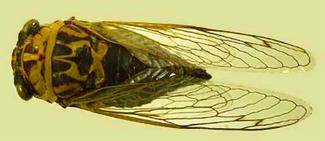
 |


Habitat
Adults: terrestrial
Immatures: terrestrial
Feeding Habits
Adults: phytophagous
Immatures: phytophagous
Size: 25 to 50 mm
Flight : strong flier
North American
Species: 9 in Canada
|
Homoptera Cicadidae
Cicadas
Front Wings: membranous
Hind Wings: membranous
Mouthparts: sucking
Antenna Length: shorter than body
Antenna Shape: straight
Front Legs: unmodified
Hind Legs: unmodified
Special Characteristics:
Cicadas are recognized by their characteristic shape and large size. The antennae are very short and bristlelike.
|
|
Species:
Tibicen canicularis (Harr)
Common Name:
Dog-day cicada
Distribution:
Comments:
Adults appear each year in July and August. Eggs are linserted into the twigs of trees and shrubs. This can cause the terminal part of the twig to die. In years when adults are numerous, the egg laying can do a lot of damage to young trees.
|

|